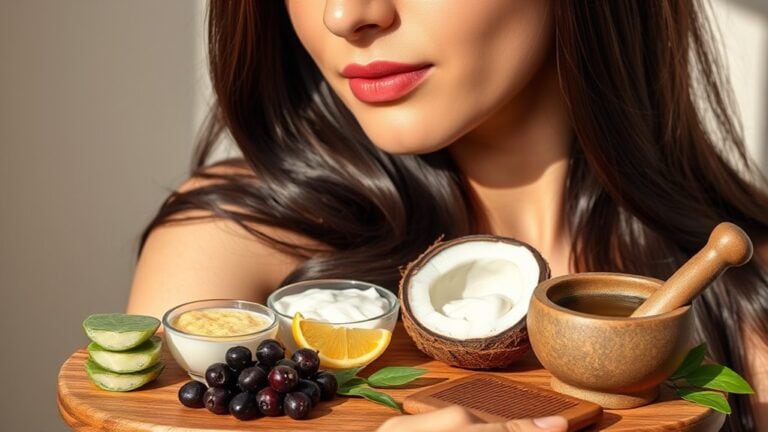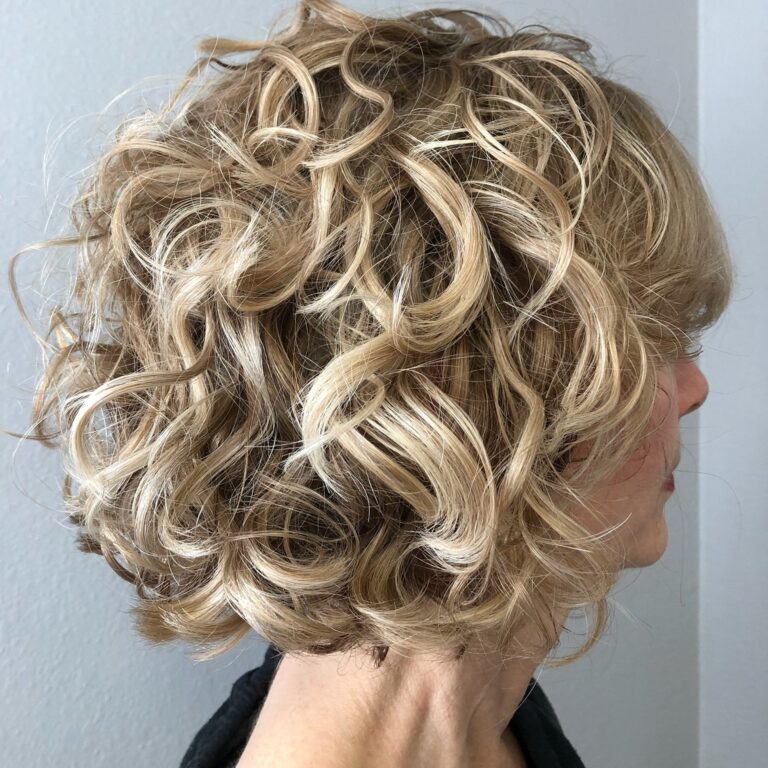Many people assume slathering conditioner all over their hair—including the scalp—boosts moisture, but this habit can backfire. The scalp naturally produces oils to stay balanced, and heavy conditioners disrupt this process through clogging pores, leading to irritation, flaking, or even slowed hair growth. While strands thrive on hydration, the scalp’s delicate skin reacts poorly to rich formulas meant for hair lengths. Comprehending this mismatch reveals why bypassing the roots keeps both scalp and hair healthier.
The Science Behind Scalp and Hair Follicle Health
Why does scalp health matter so much for strong, shiny hair? A balanced scalp microbiome health guarantees the right environment for hair to thrive, preventing issues like excess oil or dryness. Whenever harmful bacteria or fungi overgrow, they can clog follicles, slowing hair growth and causing irritation.
Follicle growth factors, natural proteins that stimulate hair production, rely on a clean, nourished scalp to work effectively. In the event that the scalp is clogged with product buildup or stripped of natural oils, these growth signals weaken, leading to thinner, weaker strands.
Inflammation or flakiness disrupts the hair cycle, making it harder for new hairs to push through. Maintaining the scalp balanced supports stronger roots, reducing breakage and promoting shine. Healthy follicles start with a well-maintained scalp—neglecting it risks dull, lifeless hair over time.
How Conditioners Work on Hair Strands vs. Scalp
Conditioners hydrate hair strands via smoothing the cuticle and sealing in moisture, yet applying them directly to the scalp can disrupt its natural oil balance.
The scalp produces sebum to protect itself, and heavy conditioners can clog pores or lead to product buildup.
This difference in function elucidates why conditioners are typically designed for mid-lengths to ends rather than roots.
Hair Shaft Hydration Process
Ever ponder how hair conditioners manage to make strands feel soft and smooth without turning the scalp into a greasy mess? The secret lies in the hair shaft hydration process. Conditioners work via coating strands, smoothing the cuticle layer integrity to lock in moisture and reduce frizz.
Ingredients like silicones and fatty alcohols create a protective barrier, preventing dryness without deep hair follicle penetration. This keeps hydration focused on the mid-lengths and ends, where damage is most common. The scalp, however, produces natural oils that maintain its balance, so adding conditioner there can lead to buildup.
Scalp Oil Balance Disruption
While conditioners excel at hydrating hair strands, their effects on the scalp tell a different story. The scalp naturally produces sebum, an oil that helps maintain moisture and protects the skin. Applying conditioner directly to the scalp can interfere with sebum production regulation, leading to either excessive oiliness or dryness.
This imbalance could trigger irritation, flakiness, or even clogged hair follicles. Additionally, conditioners often contain ingredients that disrupt the scalp microbiome, the delicate balance of beneficial bacteria and fungi. When this ecosystem is disrupted, issues like itchiness or dandruff can arise.
Unlike hair strands, which benefit from conditioning agents, the scalp thrives on minimal disturbance. Keeping conditioners mid-length to ends will ensure hydration without compromising the scalp’s natural equilibrium.
Product Buildup Risks
Why does hair sometimes feel heavy or greasy even after washing? Conditioners are designed to coat hair strands, smoothing the cuticle and adding moisture. However, applying them directly to the scalp can lead to product buildup, trapping oils and residues.
Over time, this buildup clogs hair follicles, weakening them and making hair appear limp or lifeless. The scalp’s natural balance is disrupted, increasing the risk of skin irritation, itchiness, or flakiness. Unlike hair strands, the scalp doesn’t benefit from heavy conditioning—it needs breathability to stay healthy.
Buildup can also attract dirt, making hair greasy faster. To avoid these issues, focus conditioner application on mid-lengths to ends, where hair is most damaged. This prevents unnecessary strain on follicles while keeping hair soft and manageable.
Common Problems Caused by Scalp Conditioner Buildup
Scalp conditioner buildup can lead to irritation and itching as residue clogs hair follicles. Over time, this buildup can contribute to hair thinning or shedding by weakening the roots.
Comprehension of these issues assists in preventing discomfort and preserving a healthy scalp.
Scalp Irritation and Itching
A heavy buildup of conditioner on the scalp can turn a simple wash routine into an itchy, uncomfortable ordeal. Whenever conditioner lingers too close to the roots, it traps oils, dirt, and product residue, leading to scalp inflammation and skin irritation. The scalp’s natural balance gets disrupted, causing redness, flakiness, and persistent itching.
For some, the reaction feels like a mild sunburn, while others experience tightness or a prickly sensation. Over time, the irritation can worsen if not addressed, making even gentle touches painful. Should individuals with sensitive skin or existing conditions like eczema notice stronger reactions. Rinsing thoroughly helps, but avoiding conditioner near the scalp altogether prevents the problem. The key is keeping hydration focused on the hair’s lengths and ends, where it’s needed most.
Hair Thinning and Shedding
Could conditioner left on the scalp actually lead to hair thinning? Over time, product buildup from conditioners can clog hair follicles, disrupting healthy growth. This might trigger increased shedding as weakened strands struggle to stay anchored.
The hair thinning progression worsens whether buildup blocks nutrients from reaching follicles, starving them over time. Heavy silicones or oils in conditioners can also weigh hair down, making breakage more likely. Some notice more hair in their brush or shower drain when scalp residue isn’t rinsed properly.
Whereas occasional shedding is normal, persistent buildup might accelerate loss by irritating follicles or causing inflammation. To minimize risks, focus conditioner mid-length to ends, avoiding direct scalp contact. Clarifying shampoos can help remove residue, but gentle care prevents further stress on thinning hair.
Differences Between Scalp and Hair Moisture Needs
Why do some people struggle with an oily scalp while their ends feel dry and brittle? The scalp and hair have different moisture needs due to natural oil production. The scalp produces sebum, which helps maintain its moisture barrier function, protecting it from dryness and irritation.
However, this oil doesn’t always travel down the hair shaft evenly, leaving the ends lacking hydration. Hair, especially the older strands at the tips, loses moisture over time from styling, heat, and environmental damage. Applying conditioner to the scalp can overwhelm it, disrupting its natural balance, while the ends desperately need the extra nourishment.
Comprehension of this difference helps tailor hair care routines—focusing hydration on the lengths and avoiding heavy products near the roots.
Ingredients in Conditioners That Can Irritate the Scalp
While conditioners work miracles for dry ends, certain ingredients can trigger irritation as they come into contact with the scalp. Synthetic fragrances, often added for a pleasant scent, contain chemicals that might/can cause redness, itching, or flaking in sensitive individuals.
Similarly, essential oils, though natural, can be too potent for the scalp, leading to inflammation or allergic reactions. Silicones, another common ingredient, create a coating that could/might clog pores, worsening scalp conditions like dandruff.
Heavy emollients, such as shea butter or coconut oil, can weigh down the scalp, trapping dirt and excess oil. For those with sensitive skin or existing scalp issues, these ingredients might/can disrupt the scalp’s natural balance, making it imperative/essential to avoid direct application. Choosing lightweight, scalp-friendly formulas can prevent discomfort.
Proper Application Techniques to Avoid Scalp Contact
How can someone apply conditioner without letting it touch the scalp? A targeted application technique helps focus the product on the mid-lengths and ends, where hair needs moisture most. Start by squeezing a small amount into the palms, then gently smooth it downward, avoiding the roots. An even coverage strategy guarantees the conditioner spreads without creeping toward the scalp.
Using a wide-tooth comb can help distribute the product evenly while keeping it away from the roots. Rinsing thoroughly with cool water prevents residue buildup, which can weigh hair down or irritate the scalp. For thicker hair, sectioning strands before applying ascertains no spots are missed. These steps keep the scalp free from excess product while maintaining healthy, hydrated hair.
Alternatives for Scalp Hydration Without Conditioner
For those avoiding conditioner on the scalp, other methods can still keep it hydrated and healthy. Scalp hydration doesn’t rely solely on conditioners—gentler alternatives exist to nourish without clogging pores or causing buildup.
- Scalp massages: Stimulating blood flow with fingertips boosts natural oil production, keeping the scalp moisturized.
- Herbal hair oils: Lightweight oils like jojoba or rosemary oil hydrate without heaviness, ideal for sensitive scalps.
- Aloe vera gel: Soothes and moisturizes, offering a cooling effect while balancing scalp moisture.
- Hydrating sprays: Water-based mists with glycerin or hyaluronic acid provide instant hydration without residue.
These options prevent greasiness while tackling dryness, making them practical for daily use. Choosing the right method depends on individual scalp needs, ensuring comfort and health without conditioner contact.
Myths and Misconceptions About Scalp Conditioning
Many people believe applying conditioner directly to the scalp causes excessive oiliness or clogged pores, but this isn’t always true. The right product, used sparingly, can actually support scalp health without weighing hair down. Misconceptions often stem from using heavy formulas or skipping proper scalp cleansing routines. Seasonal scalp needs also play a role—dry winters could call for light hydration, while humid summers might require lighter products.
| Myth | Reality |
|---|---|
| Conditioner always clogs pores | Lightweight formulas can nourish without buildup |
| Scalp doesn’t need moisture | Balanced hydration prevents flakiness and irritation |
| All conditioners work the same | Ingredients matter—avoid silicones for sensitive scalps |
| Oily scalps can’t handle conditioner | Oil-free options exist for balanced care |
Understanding these nuances helps tailor care without fear.
Conclusion
As the sun sets on a long day, a woman rinses her hair, careful to keep the conditioner away from her scalp—just as her stylist advised. Coincidentally, her friend complains of an itchy scalp after slathering conditioner everywhere. The woman smiles, understanding her small habit spares her the same fate. Healthy hair starts with a happy scalp, and sometimes, the simplest choices make all the difference.





